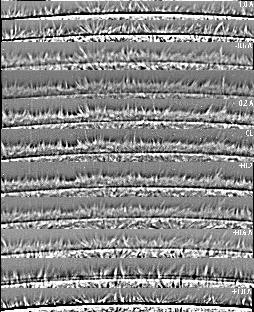| |
The Chromosphere
of the Sun
|
The gases of the Sun extend far beyond the photosphere, which may be considered
the lowest level of the solar atmosphere. The region immediately
above the photosphere is called the chromosphere.
Observation of the Chromosphere

|
|
Spicules on the solar limb
|
The chromosphere is 2000-3000 km
thick.
It glows
faintly relative to the photosphere and can only be seen easily in a total
solar eclipse. When it can be seen it is reddish in color (because of strong
Balmer H-alpha emission). This color is the origin of its name
(chromos meaning ``color'').
The faint flow of the chromosphere is due to an emission spectrum from hot, low
density gases emitting at discrete wavelengths. The discovery of helium noted
earlier was from emission lines seen in the chromosphere during an eclipse in
1868. This new element was only found on the Earth in 1895.
Spicules
The chromosphere contains spikes of gas called spicules that rise
through it. The adjacent image shows spicules on the limb of the Sun
as imaged by the Big Bear Solar
Observatory
(Ref). This image is a superposition of 11 limb images taken at
different wavelengths. In this image the longest spicules rise about 7000 km.
Spicules are short-lived phenomena, corresponding to rising jets of gas that
move upward at about 30km/sec and last only about 10 minutes.

